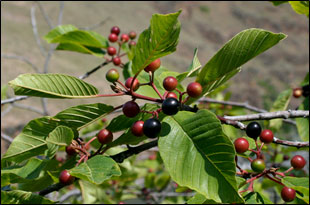Rhamnus purshiana in the Landscape

William R. Graves, Iowa State University
Scientfic Name: Rhamnus purshianaCommon Name: Cascara buckthorn
Description: Cascara buckthorn matures to be a large shrub or small tree. With a height of about 30 feet, the canopy is rounded and has a medium to coarse texture. The elliptical leaves are arranged alternately. They are glossy-green during the growing season but become yellow and perhaps orange to red in autumn, especially on plants exposed to full sun. Although the flowers are not significant as ornamental features, the fleshy fruits (drupes) add color to the landscape in late summer and autumn. Each fruit is small (about 1/3" diameter), but many form. They transition from green when immature to red and finally dark blue when ripe in autumn. The colorful leaves accentuate the visual impact of the dark blue fruits. Flowers attract butterflies; fruits
Native Habitat: Southern British Columbia south and east to southern California and Arizona and West Texas; prevalent throughout Washington, northern Idaho, extreme western Montana, and western Oregon.
Cultural Requirement
Soil: Tolerant of various levels of pH; rich, well-drained soils preferred.
Moisture Tolerance: Dry to seasonally wet.
Sun/Shade/Preference: Tolerant of sun or shade, though best ornamental value in partial to full sun.
Transplanting: A well-branched root system makes transplanting trouble-free.
Propagation: Seed, perhaps softwood stem cuttings.
Maintenance (pruning, fertilization, deadheading, division, irrigation, etc): Not demanding; pest problems rare; no pruning required.
Landscape Value
Use in the Landscape: Small tree as focal point or for naturalizing.
Foliage: Glossy green, yellow to orange/red in autumn.
Timing: May
Color: Creamy-white.
Fruit: Fleshy drupes (green-burgundy-dark blue).
Form: Small tree with round crown.
Texture: Medium to coarse.
Ultimate Size: 30' tall.
Rate of Growth: Moderate to rapid.
Suggested Plant Partners: Ornamental grasses.
Availability: Nurseries specializing in native plants.
Cultivars: None.
References:
Preston, R.J. 1947. Rocky Mountain Trees. The Iowa State College Press, Ames, Iowa.
USDA Plant Database

